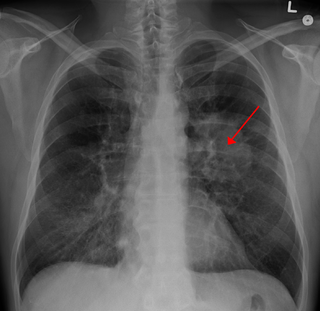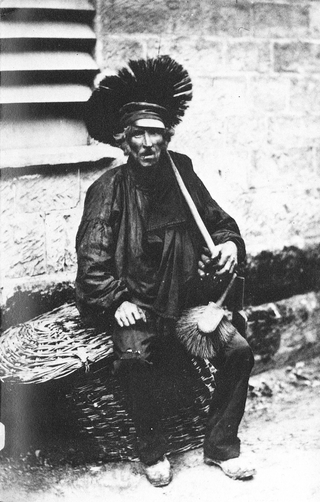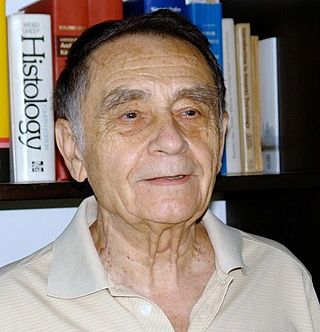
Lung cancer, also known as lung carcinoma, is a malignant tumor that begins in the lung. Lung cancer is caused by genetic damage to the DNA of cells in the airways, often caused by cigarette smoking or inhaling damaging chemicals. Damaged airway cells gain the ability to multiply unchecked, causing the growth of a tumor. Without treatment, tumors spread throughout the lung, damaging lung function. Eventually lung tumors metastasize, spreading to other parts of the body.

In genetics, a mutagen is a physical or chemical agent that permanently changes genetic material, usually DNA, in an organism and thus increases the frequency of mutations above the natural background level. As many mutations can cause cancer in animals, such mutagens can therefore be carcinogens, although not all necessarily are. All mutagens have characteristic mutational signatures with some chemicals becoming mutagenic through cellular processes.

A chimney sweep is a person who clears soot and creosote from chimneys. The chimney uses the pressure difference caused by a hot column of gas to create a draught and draw air over the hot coals or wood enabling continued combustion. Chimneys may be straight or contain many changes of direction. During normal operation, a layer of creosote builds up on the inside of the chimney, restricting the flow. The creosote can also catch fire, setting the chimney alight. The chimney must be swept to remove the soot.

Johannes Andreas Grib Fibiger was a Danish physician and professor of anatomical pathology at the University of Copenhagen. He was the recipient of the 1926 Nobel Prize in Physiology or Medicine "for his discovery of the Spiroptera carcinoma". He demonstrated that the roundworm which he called Spiroptera carcinoma could cause stomach cancer in rats and mice. His experimental results were later proven to be a case of mistaken conclusion. Erling Norrby, who had served as the Permanent Secretary of the Royal Swedish Academy of Sciences and Professor and Chairman of Virology at the Karolinska Institute, declared Fibiger's Nobel Prize as "one of the biggest blunders made by the Karolinska Institute."

Benzo[a]pyrene (BaP or B[a]P) is a polycyclic aromatic hydrocarbon and the result of incomplete combustion of organic matter at temperatures between 300 °C (572 °F) and 600 °C (1,112 °F). The ubiquitous compound can be found in coal tar, tobacco smoke and many foods, especially grilled meats. The substance with the formula C20H12 is one of the benzopyrenes, formed by a benzene ring fused to pyrene. Its diol epoxide metabolites, more commonly known as BPDE, react with and bind to DNA, resulting in mutations and eventually cancer. It is listed as a Group 1 carcinogen by the IARC. In the 18th century a scrotal cancer of chimney sweepers, the chimney sweeps' carcinoma, was already known to be connected to soot.
An occupational disease or industrial disease is any chronic ailment that occurs as a result of work or occupational activity. It is an aspect of occupational safety and health. An occupational disease is typically identified when it is shown that it is more prevalent in a given body of workers than in the general population, or in other worker populations. The first such disease to be recognised, squamous-cell carcinoma of the scrotum, was identified in chimney sweep boys by Sir Percival Pott in 1775. Occupational hazards that are of a traumatic nature are not considered to be occupational diseases.
Occupational lung diseases comprise a broad group of diseases, including occupational asthma, industrial bronchitis, chronic obstructive pulmonary disease (COPD), bronchiolitis obliterans, inhalation injury, interstitial lung diseases, infections, lung cancer and mesothelioma. These can be caused directly or due to immunological response to an exposure to a variety of dusts, chemicals, proteins or organisms. Occupational cases of interstitial lung disease may be misdiagnosed as COPD, idiopathic pulmonary fibrosis, or a myriad of other diseases; leading to a delay in identification of the causative agent.

Verrucous carcinoma (VC) is an uncommon variant of squamous cell carcinoma. This form of cancer is often seen in those who chew tobacco or use snuff orally, so much so that it is sometimes referred to as "Snuff dipper's cancer".

Surgery is the branch of medicine that deals with the physical manipulation of a bodily structure to diagnose, prevent, or cure an ailment. Ambroise Paré, a 16th-century French surgeon, stated that to perform surgery is, "To eliminate that which is superfluous, restore that which has been dislocated, separate that which has been united, join that which has been divided and repair the defects of nature."

Sir James Earle (1755–1817) was a celebrated British surgeon, renowned for his skill in lithotomy.

Chimney sweeps' cancer, also called soot wart or scrotal cancer, is a squamous cell carcinoma of the scrotum. It has the distinction of being the first reported form of occupational cancer, and was initially identified by Percivall Pott in 1775. It was initially noticed as being prevalent amongst chimney sweeps. The disease has also been seen in men exposed to mineral oil and those who worked with coal distillates.

Mule spinners' cancer or mule-spinners' cancer was a cancer, an epithelioma of the scrotum. It was first reported in 1887 in a cotton mule spinner. In 1926, a British Home Office committee strongly favoured the view that this form of cancer was caused by the prolonged action of mineral oils on the skin of the scrotum, and of these oils, shale oil was deemed to be the most carcinogenic. From 1911 to 1938, there were 500 deaths amongst cotton mule-spinners from cancer of the scrotum, but only three amongst wool mule spinners.

Mirosław Jan Stasik was a Polish medical doctor and research toxicologist.

Henry Earle FRS (1789–1838) was an English surgeon.

The history of cancer describes the development of the field of oncology and its role in the history of medicine.

Thomas Kirkland M.D. (1721–1798) was an English physician and medical writer.
The following outline is provided as an overview of and topical guide to trauma and orthopaedics:
The treatment of broken bones and dislocated joints can be traced as far back as the Ancient Greeks. Hippocrates is credited with a method of reduction of a dislocated shoulder. 16th century Spanish texts talk about the Aztecs use of reduction of fractures using fir branches. The modern discipline of orthopaedics in trauma care developed during the course of World War I, but it was not until after World War II that orthopaedics became the dominant field treating fractures in much of the world. Today, the discipline encompasses conditions such as bone fractures and bone loss, as well as spinal pathology and joint disease.
Cancer prevention is the practice of taking active measures to decrease the incidence of cancer and mortality. The practice of prevention is dependent upon both individual efforts to improve lifestyle and seek preventive screening, and socioeconomic or public policy related to cancer prevention. Globalized cancer prevention is regarded as a critical objective due to its applicability to large populations, reducing long term effects of cancer by promoting proactive health practices and behaviors, and its perceived cost-effectiveness and viability for all socioeconomic classes.
Occupational cancer is cancer caused by occupational hazards. Several cancers have been directly tied to occupational hazards, including chimney sweeps' carcinoma, mesothelioma, and others.
















